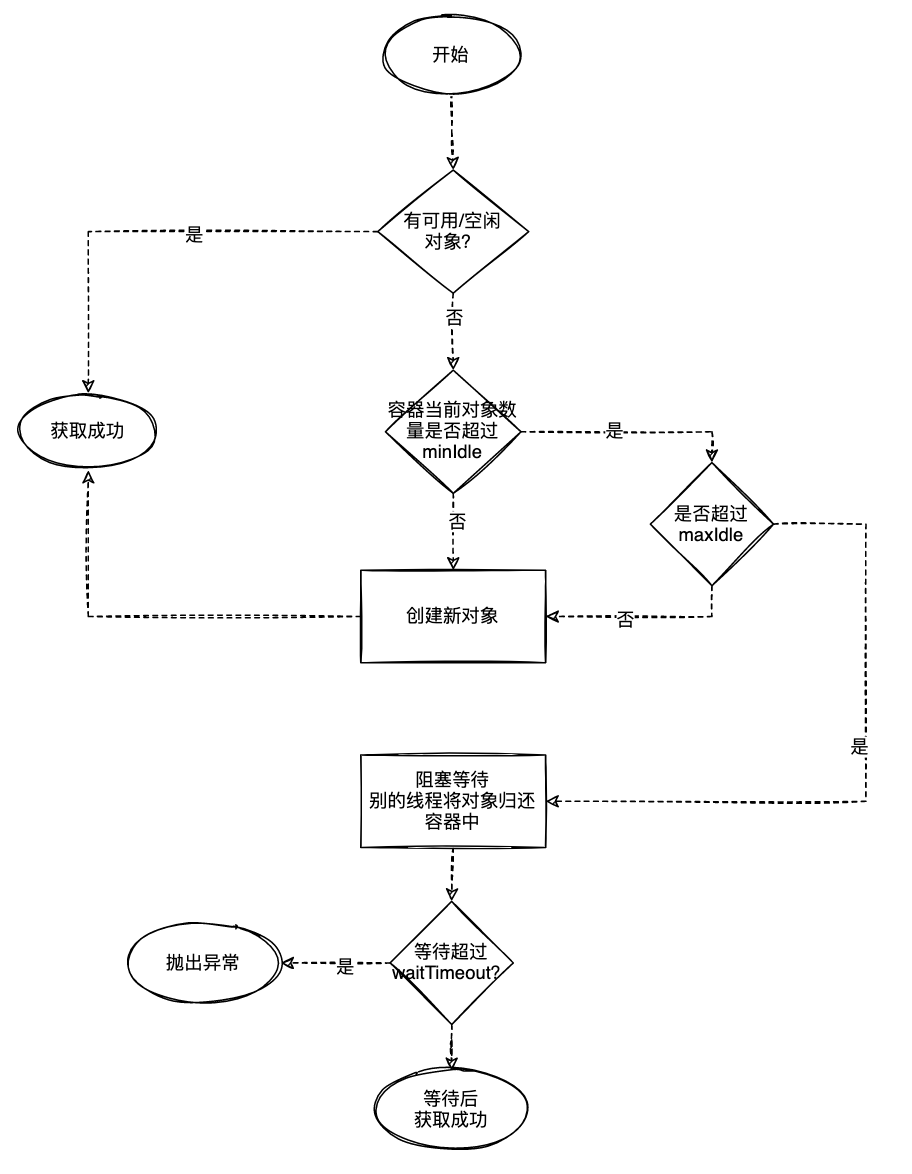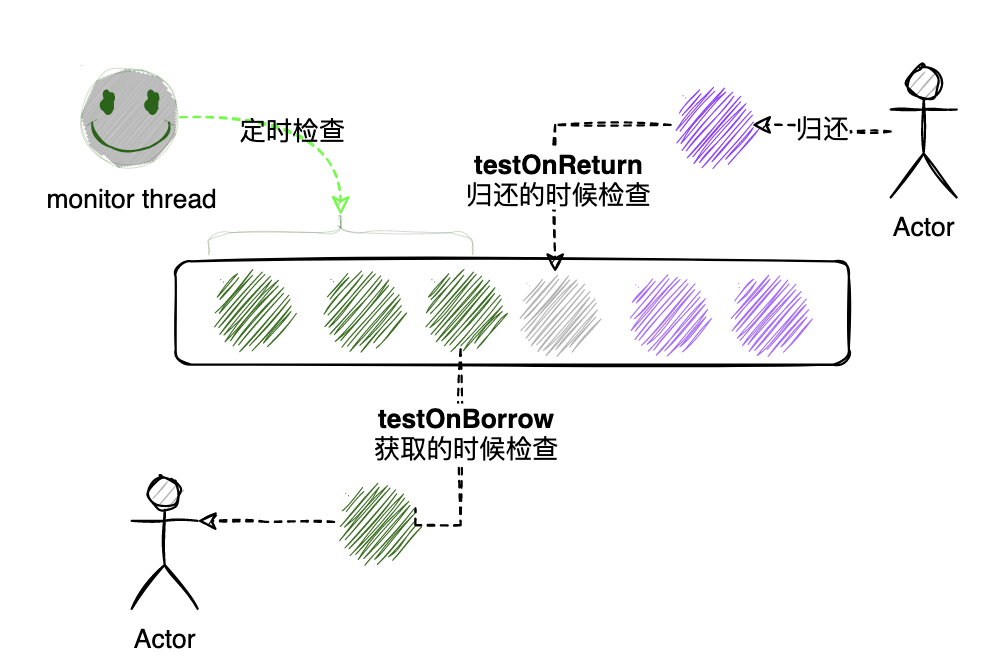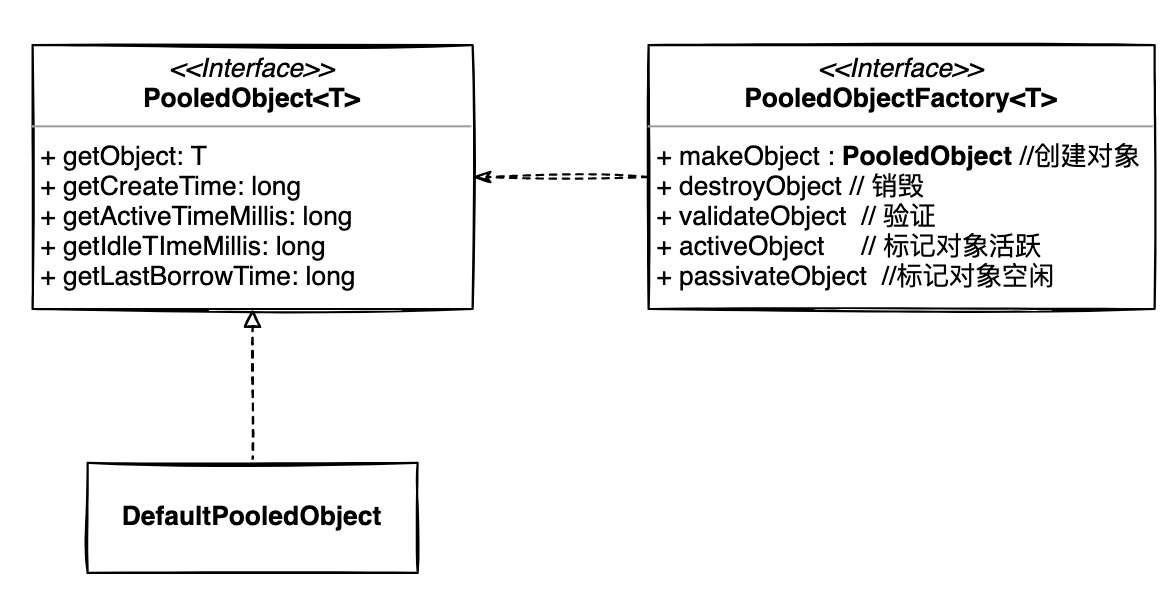对象池技术和通用实现GenericObjectPool
对象池技术其实蛮常见的,比如线程池、数据库连接池
他们的特点是:对象创建代价较高、比较消耗资源、比较耗时;
比如 mysql数据库连接建立就要先建立 tcp三次握手、发送用户名/密码、进行身份校验、权限校验等很多步骤才算是 db连接建立成功;要是每次使用的时候才去创建会比较影响性能,而且也不能无限制的创建太多
所以,这种对象使用完后不立即释放资源,一般是先放到一个池子里暂存起来,下次就能直接从池子里拿出现成可用的对象
对象池需要具备的能力
所以,为了让这类资源对象的使用方能够复用资源、快速获取可用对象,这个池子得具备的能力有哪些?
- 首先有个容器的数据结构,能存放多个对象,也有数量上限
- 维持一定数量的常驻对象,这个数量如果和
qps * rt匹配的话,业务处理就都能直接获取可用对象,不需要消耗对象创建的时间了 - 能应对突发流量
- 超时获取,一定时间没有获取成功就抛出异常,不卡死业务线程
- 具有活性检测机制, 从容器拿出来的对象得是可用的
1 核心流程
1.1对象获取流程

1.2 活性检测

2 实现
为了实现前面提到的容器具备的能力,以及对象获取流程,需要考虑几个东西:
-
容器的数据结构选择
用 List、 Map 还是 Queue ?亦或是组合起来用? -
空闲对象要不要单独用要给集合存一份?方便判断是否空、阻塞等待?
比如将空闲对象,用一个blockingqueue存一下,就能利用阻塞队列的能力实现超时等待 -
检测机制
- 在什么时候检测:常见的有 testOnBorrow 在申请到的时候检测、testOnReturn在归还的时候检测 这两个对性能有些影响; 单独开个检查线程,定时去扫描检查,这个是异步的 不会有testOnBorrow和testOnReturn的性能影响
- 检测哪些对象: 比如空闲超过 500ms 的对象
- 如何检查:这个需要根据具体对象的类型来,比如db连接的话一般是发送 “select 1” 看是否能正常执行
3 一个通用实现 apache commons pool
通过前面的介绍,可以知道对象池技术的核心过程大同小异,可以将对象获取流程、活性检测机制等封装成一个通用的工具,将对象本身的创建、活性检测逻辑开放给具体的对象实现来完成; apache commons pool 就是这么个工具, jedis底层的连接池就是直接用的这个
3.1 核心数据结构
LinkedBlockingDeque<PooledObject<T>> idleObjects空闲对象双向阻塞队列Map<IdentityWrapper<T>, PooledObject<T>> allObjects = new ConcurrentHashMap<>();所有对象的map
apache commons pool 的容器用的 ConcurrentHashMap,并且将空闲的对象用一个双向阻塞队列单独连接起来;
这样他就能利用这个阻塞队列本身的特性,达到阻塞获取的逻辑,如果 idleObjects 是空的,就能 take()/poll(timeout) 阻塞在这里,等待其他线程归还对象队列里
3.2 核心对象定义
- PooledObject 可池化的对象:包含真实对象、状态扭转及其创建时间、取出时间、空闲时间等指标信息
- PooledObjectFactory 对象工厂,负责对象的创建、销毁、检查等逻辑;它有个默认实现
DefaultPooledObject 提供了基本的实现,一般只要继承它重写对象创建和验活逻辑就可以了 - GenericObjectPool 就是对象容器了

3.3 代码细节
从池子中获取对象
T borrowObject(final long borrowMaxWaitMillis) { //省略一些代码 ... PooledObject<T> p = null; // Get local copy of current config so it is consistent for entire // method execution final boolean blockWhenExhausted = getBlockWhenExhausted(); boolean create; final long waitTime = System.currentTimeMillis(); while (p == null) { create = false; // 空闲队列 队首如果是空的,则创建一个新的对象 // 创建的逻辑里会校验是否超过最大连接数,然后利用 PooledObjectFactory创建对象 p = idleObjects.pollFirst(); if (p == null) { p = create(); if (p != null) { create = true; } } // 阻塞从 idleObject 空闲阻塞队列获取对象 if (blockWhenExhausted) { if (p == null) { if (borrowMaxWaitMillis < 0) { p = idleObjects.takeFirst(); } else { //超时等待 p = idleObjects.pollFirst(borrowMaxWaitMillis, TimeUnit.MILLISECONDS); } } if (p == null) { throw new NoSuchElementException( "Timeout waiting for idle object"); } } else { if (p == null) { throw new NoSuchElementException("Pool exhausted"); } } // 状态转换为已分配 ALLOCATE,记录借出时间等信息 if (!p.allocate()) { p = null; } if (p != null) { try { // 允许 PooledObjectFactory 在成功获取到对象后做一些事, // 比如jedis连接池获取到连接后会执行 select db 切换db factory.activateObject(p); } catch (final Exception e) { try { destroy(p); } catch (final Exception e1) { // Ignore - activation failure is more important } p = null; if (create) { final NoSuchElementException nsee = new NoSuchElementException( "Unable to activate object"); nsee.initCause(e); throw nsee; } } // 如果 testOnBorrow=true, 或者 testOnCreate=true + 此次对象是新建的 // 则会去校验对象的有效性 PooledObjectFactory#validateObject() if (p != null && (getTestOnBorrow() || create && getTestOnCreate())) { boolean validate = false; Throwable validationThrowable = null; try { validate = factory.validateObject(p); } catch (final Throwable t) { PoolUtils.checkRethrow(t); validationThrowable = t; } // 如果对象有效性校验失败,则销毁掉 if (!validate) { try { destroy(p); destroyedByBorrowValidationCount.incrementAndGet(); } catch (final Exception e) { // Ignore - validation failure is more important } p = null; if (create) { final NoSuchElementException nsee = new NoSuchElementException( "Unable to validate object"); nsee.initCause(validationThrowable); throw nsee; } } } } } updateStatsBorrow(p, System.currentTimeMillis() - waitTime); return p.getObject(); }
归还对象
public void returnObject(final T obj) { // 校验下对象是否还存在 final PooledObject<T> p = allObjects.get(new IdentityWrapper<>(obj)); if (p == null) { if (!isAbandonedConfig()) { throw new IllegalStateException( "Returned object not currently part of this pool"); } return; // Object was abandoned and removed } // 状态标记为 “归还中” synchronized(p) { final PooledObjectState state = p.getState(); if (state != PooledObjectState.ALLOCATED) { throw new IllegalStateException( "Object has already been returned to this pool or is invalid"); } p.markReturning(); // Keep from being marked abandoned } final long activeTime = p.getActiveTimeMillis(); // 如果 testOnReturn=true,则在归回时校验对象是否还有效,如果无效了就销毁掉 if (getTestOnReturn()) { if (!factory.validateObject(p)) { try { destroy(p); } catch (final Exception e) { swallowException(e); } try { ensureIdle(1, false); } catch (final Exception e) { swallowException(e); } updateStatsReturn(activeTime); return; } } try { factory.passivateObject(p); } catch (final Exception e1) { swallowException(e1); try { destroy(p); } catch (final Exception e) { swallowException(e); } try { ensureIdle(1, false); } catch (final Exception e) { swallowException(e); } updateStatsReturn(activeTime); return; } if (!p.deallocate()) { throw new IllegalStateException( "Object has already been returned to this pool or is invalid"); } // 如果此时对象池已经关闭了, 或者当前空闲对象数量大于maxIdle(最大空闲数量)则直接销毁掉 final int maxIdleSave = getMaxIdle(); if (isClosed() || maxIdleSave > -1 && maxIdleSave <= idleObjects.size()) { try { destroy(p); } catch (final Exception e) { swallowException(e); } } else { if (getLifo()) { idleObjects.addFirst(p); } else { idleObjects.addLast(p); } if (isClosed()) { // Pool closed while object was being added to idle objects. // Make sure the returned object is destroyed rather than left // in the idle object pool (which would effectively be a leak) clear(); } } updateStatsReturn(activeTime); }
开启定期检查任务
final void startEvictor(final long delay) { synchronized (evictionLock) { // 关闭前已有的清理任务 if (null != evictor) { EvictionTimer.cancel(evictor, evictorShutdownTimeoutMillis, TimeUnit.MILLISECONDS); evictor = null; evictionIterator = null; } // 间隔时间大于0的话(默认为-1),才创建定时清理任务Evictor // Evictor 是一个 Runable任务, 它会检查空闲队列里的对象数量是否超过 maxIdle,空闲时长是否超过 minEvictableTimeMillis if (delay > 0) { evictor = new Evictor(); EvictionTimer.schedule(evictor, delay, delay); } } }
总结
apache commons pool 的对象池实现,比较通用,在性能要求不是太苛刻的情况下可以直接使用;
但是默认的对象实现在状态扭转等地方是用 synchronized 加锁来处理并发的,如果对性能要求比较高的话,需要考虑自定义其他实现方式,比如用 cas + retry 或 threadlocal 等方式减少并发冲突
本文来自博客园,作者:mushishi,转载请注明原文链接:https://www.cnblogs.com/mushishi/p/14998069.html





